India

India has always been in my mind a place to go at least once in life and for my first travel there I chose a classic destination: Rajasthan. I did not have any particular expectation about this country but still I was interested in to know why so many people are fascinated by it. I was not disappointed as Rajasthan is a good combination of forts, deserts, spices and temples. The travel was intense because the distances to cover were huge but it didn't impact the beautiful time we got to spend in every city.
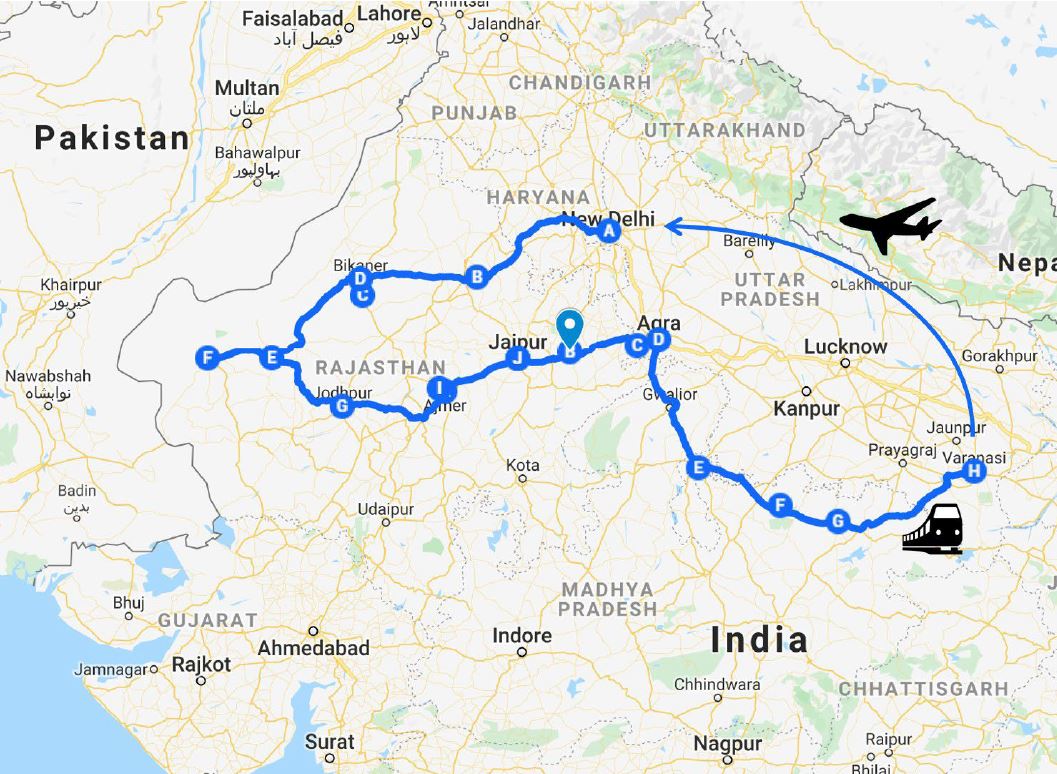 This is the first travel I did to India and it was definitely intense. Every day we had at least 5/7
hours on
the bus because the distance between each leg was quite big and the roads in India are not even
close to what
we are used here in Europe. As the first bite of this huge country, I chose Rajasthan and I
travelled
with the same agency I travelled to Sri Lanka before, Viaggi e Avventure nel Mondo. Before
digging
into the specifics of the travel, though, I think a brief introduction is important.
This is the first travel I did to India and it was definitely intense. Every day we had at least 5/7
hours on
the bus because the distance between each leg was quite big and the roads in India are not even
close to what
we are used here in Europe. As the first bite of this huge country, I chose Rajasthan and I
travelled
with the same agency I travelled to Sri Lanka before, Viaggi e Avventure nel Mondo. Before
digging
into the specifics of the travel, though, I think a brief introduction is important.
Rajasthan, known as the Land of Kings, is the richest region of India with fortresses and
majestic
architectonical works. This is the land of the Rajput, warrior clans who controlled the
region for over
a thousand years. However, being all of them always at war with each other for pride reasons,
reduced them to
be dependent on the Moghul Empire. After this empire collapsed, the Rajput tried to find an
agreement
with the English in order to be independent states under the English domination of India. Even after
the
Indian independence in 1947, many Maharajas maintained titles and properties. Finally, in the 70ies,
Rajasthan, too, had to submit to the central control of the country. Nowadays, lost his power due to
trade
routes, Rajasthan is a popular touristic destination and maybe one of the most visited regions of
the country.
For this reading, I suggest listening to Mahalaxmi Mantra Om Mahalaxmi Namo Namah Shri
Mahalaxmi. This was
a mantra we listened to during Diwali. It is quite long so it may not be even finished once you
arrive at the
end of the reading.
Day 1
The very first day, the 18th of October, was the flight day. I met all the other participants
(except for one)
at the airport and it was exciting. I was so looking forward to going to India! We were 11 people
including
the coordinator: me, two girls, Jessica and Giulia, that already knew each other and were just one
year older
than me, Mauro, 50ish guy that traveled a lot already, Maurizio, 50ish guy, banker, Efrem, 40ish
guy,
policeman, Matteo and Rachele, super young couple of 22 that stayed most of the time on its own,
Carmine, 39
years old guy, Laura, the coordinator, 70ish. The first flight took us from Milan to Istanbul, where
we met
Marco, the 11th person, two years older than me and very nice. There, we also discovered that our
flight to
Delhi was delayed so we waited some hours in the airport. Then, they decided to anticipate the
flight and we
almost lost Marco there as he went for a walk. Thankfully, we all made it to the plane and, after 7
hours, we
arrived in India!
Day 2
We arrived in India in the morning completely exhausted. And then a long 7 hours transfer was
waiting for us.
After we met the guy from the agency that had all our hotel reservations and documents, we walked to
the bus.
Our driver was a peculiar guy that spoke close to no English.
 Our very first destination was Mandawa, already in the region of Rajasthan. It is quite
popular among
tourists, that stop here to see the famous Havelis. These are houses built by rich merchants
starting
in the XVIII century, when new commercial ways were opened, to show off. The richer the decorations,
the
better. The name haveli means private space and it then became the term to indicate these specific
buildings.
Usually, Havelis are formed by two or more courtyards, the inner one for the women and private life
for the
family, where the merchants were welcomed, and deals were made.
In this part of India, Havelis are decorated mostly with frescoes depicting gods (still not sure how
many
there are in Hinduism, 33 million, 330 million or more!) and later also trains, phones, planes. They
are very
beautiful but many of the houses we saw in Mandawa were left abandoned. This is something we found
in every
place we visited, and the abandonment is part of the charm even though from a European perspective,
this
sounds like a crime.
We walked around the city in the late afternoon with two guys who guided us but, when dinner time
arrived, we
were more than happy to go back to the hotel (a haveli, too!) and rest a bit.
The first dinner was good and an introduction to Indian cuisine: naan, spices, lentils, spices,
paneer,
spices… super tasty, especially if you are into spices!
Our very first destination was Mandawa, already in the region of Rajasthan. It is quite
popular among
tourists, that stop here to see the famous Havelis. These are houses built by rich merchants
starting
in the XVIII century, when new commercial ways were opened, to show off. The richer the decorations,
the
better. The name haveli means private space and it then became the term to indicate these specific
buildings.
Usually, Havelis are formed by two or more courtyards, the inner one for the women and private life
for the
family, where the merchants were welcomed, and deals were made.
In this part of India, Havelis are decorated mostly with frescoes depicting gods (still not sure how
many
there are in Hinduism, 33 million, 330 million or more!) and later also trains, phones, planes. They
are very
beautiful but many of the houses we saw in Mandawa were left abandoned. This is something we found
in every
place we visited, and the abandonment is part of the charm even though from a European perspective,
this
sounds like a crime.
We walked around the city in the late afternoon with two guys who guided us but, when dinner time
arrived, we
were more than happy to go back to the hotel (a haveli, too!) and rest a bit.
The first dinner was good and an introduction to Indian cuisine: naan, spices, lentils, spices,
paneer,
spices… super tasty, especially if you are into spices!
Day 3
The day after we were more rested and eager to be on the road. Our first stop, not so far from
Mandawa, was
Fatehpur, a city founded in 1451 and full of Havelis. We went to see Le Prince Haveli, a
beautiful
building bought and completely restored by the French artist Nadine Le Prince and turned into a
guesthouse for
artists and a hotel. There we had a guided visit by a French girl who resides there who explained
very well
the haveli history and all the functions it had.
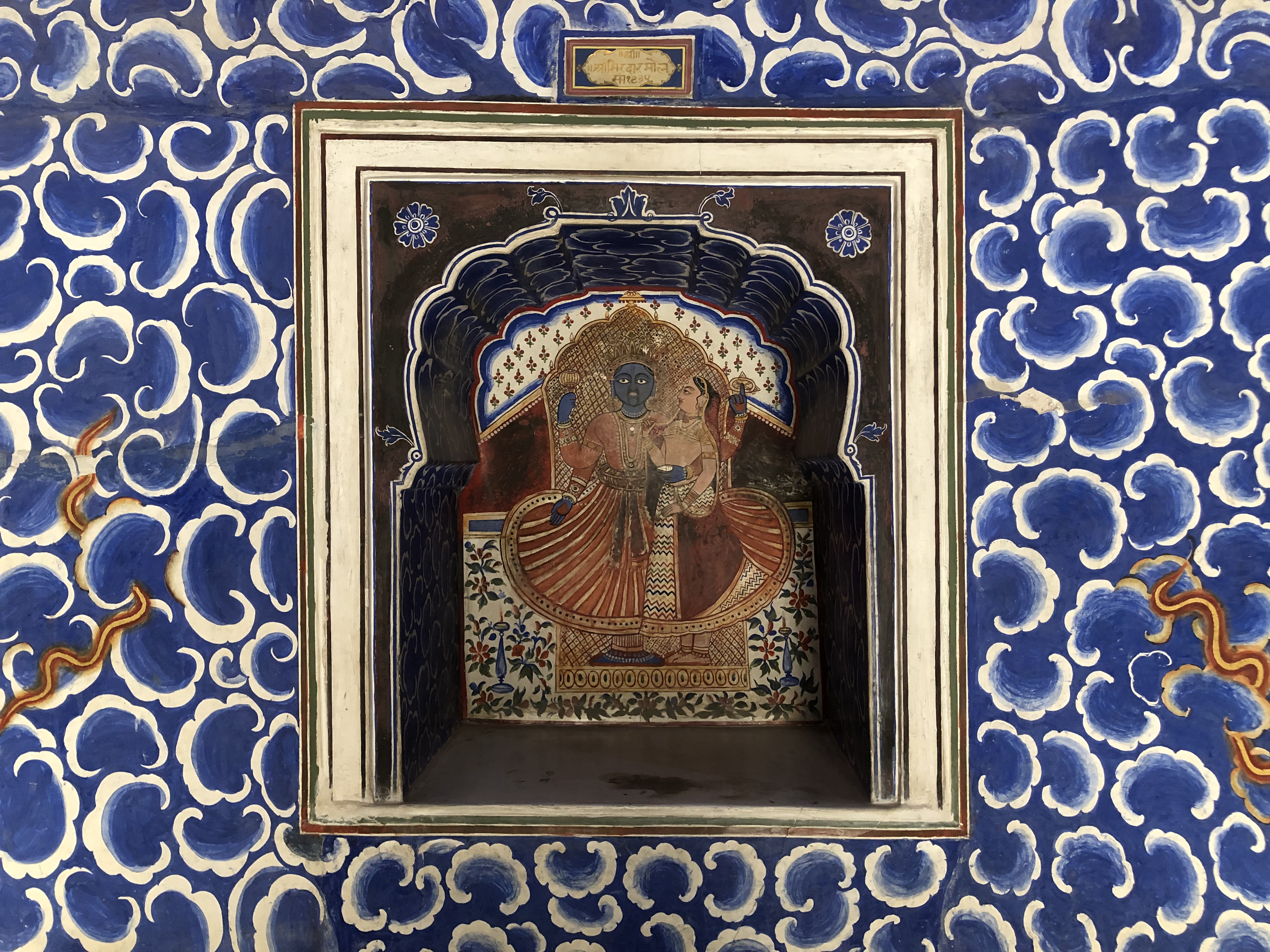
After seeing all these frescoes, we moved to Deshnok, where there is the famous Karni
Mata Temple,
also known as the Temple of Rats. Yes, rats. The story says that, when Karni Mata’s son died,
she, as
the reincarnation of Durga (one of the forms of Devi, the divine mother), brought him back to life
and decided
that the members of the family would not die but would reincarnate in kaba (rats). Nowadays, many
citizens of
Deshnok believe they descend from her and the rats are their ancestors. Besides all these
religion/mythos
stories, the temple is quite fascinating. You enter and see rats pretty much everywhere, especially
where the
devotes leave food offers. I had not the luck of having a rat stepping on my feet, but maybe that
was not so
bad.
Finally, we reached Bikaner, our last stop for the day. Bikaner is a desert city with a
fort and
that was an important stop for the caravans in the XVI century. We visited the fort that was
impressive for
the size and the decorations. Later we had a walk in the city with a guide and saw some other
Havelis, the
market, and a Jain temple.
Maybe some extra info about the religions in India is at this point necessary.
Hinduism is the main religion in India with 80.5% of the population. The main
characteristic is to believe in Brahman, an infinite force that generates everything and
to which
everything will eventually go back. As I said, I still don’t know how many gods there are, even
the guides
seemed to be a little bit confused on this point. However, the main are Brahma, the generator,
Vishnu, the
operator, and Shiva, the destroyer. My favorite god is Ganesh, also the easiest to identify, who
brings
luck.
13.4% of the population is Islamic, the biggest religious minority. Islam arrived around the
XVII century
when the Moghul Empire controlled the north part of the country.
Other minorities are Sikhism, concentrated especially in Punjab and born as a revolt to the
caste system and
to the Muslim domination, the Buddhism, born in India but nowadays practiced by less than 1% of
the
population, and Jainism, as well born as a revolt to the caste system. The Jains believe that to
be
completely free, we need to get rid of the superficial, practicing a life of austerity, and
don’t kill any
form of life. Most extremes wear something in front of their mouth not to accidentally kill an
insect and
the monks usually have just a piece of fabric to cover themselves. –
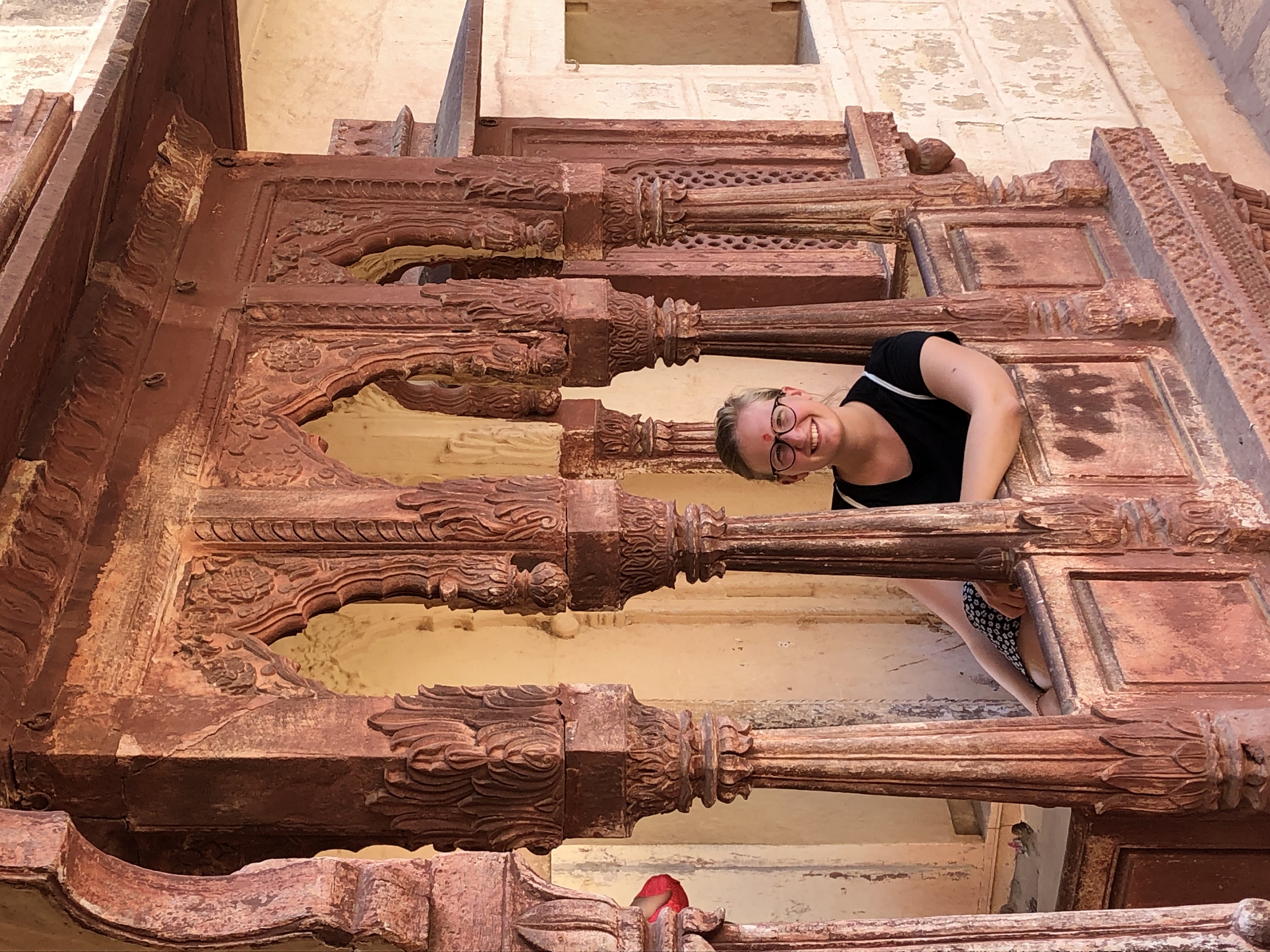 Day 4
Day 4
Back on the road the day after, we arrived in Pokhran,
a city famous for its fort (we saw maaaany
forts). The building itself was beautiful but, as for the others we saw, there was nothing inside
nor it was
easy for us Europeans to completely appreciate it. However, we had an incredible guide that took us
around. He
knew maybe three or four words in Italian but what an entertainer! He took us pictures in the best
spots of
the palace and made us enjoy every minute we spent there.
And then we were on the bus again to our destination of the day, the city of Jaisalmer. On
the way, we
stopped at Bada Bagh, where we saw the sunset at the cenotaphs of the Rajasthan maharajas.
The view was
great, and it was a good conclusion for the day.
We then drove to our hotel that which was, once again, a haveli. This time, instead of frescoes, the
decorations were made directly into the stone that was marvelously carved. It is typical of this
area, and
then further also in Jodhpur and Jaipur to have this kind of decoration, maybe also because
Jaisalmer is in
the desert and stones survive better than painting to sand.
Day 5
We spent all day walking around Jaisalmer. It is a beautiful city with its own charm. From afar, the
first
thing you see is its fort, which seems a huge sand construction even though is quite a solid
rock
building that survived intact for more than 800 years. Jaisalmer was a very important city back in
the
centuries due to its strategic commercial position: only about 100 km west there is the border with
Pakistan.
However, after the wars between India and Pakistan in more recent decades, its power declined until
it became
only a popular destination for tourism. From the terrace of our hotel, you could have an impressive
view of
the fort, where over 3000 people reside, and the surrounding city.
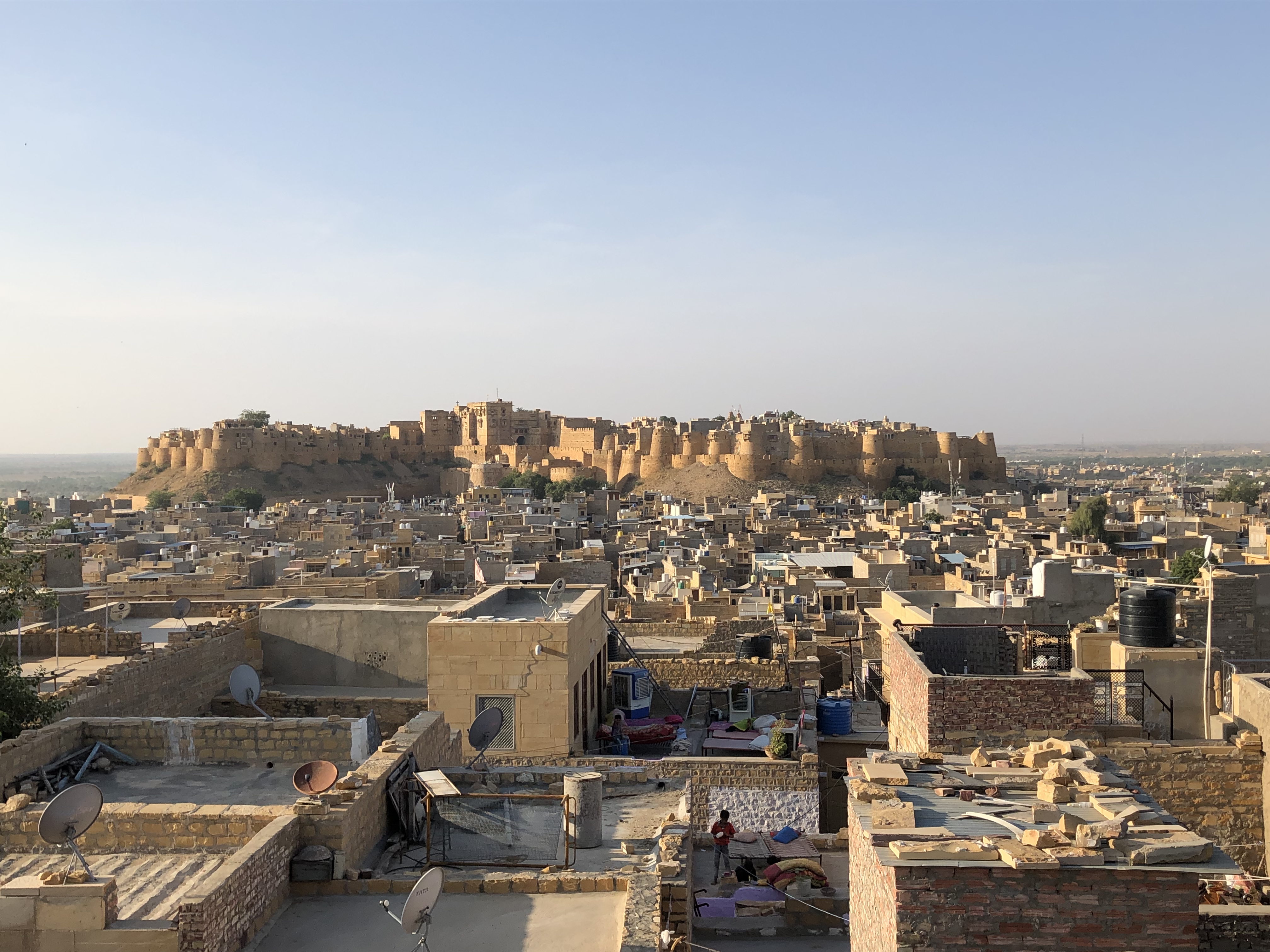 The visit was super interesting, as the guide was very informative and spoke good Italian. Of
course, as any
other guide we had, we had to stop in his shop. And of course, I bought something. I fell in love
with a
cashmere scarf that I plan to use a lot this winter. We visited some Havelis (yes, again) and
various Jain
temples until evening. Then, we head to dinner in a restaurant with a beautiful terrace.
The visit was super interesting, as the guide was very informative and spoke good Italian. Of
course, as any
other guide we had, we had to stop in his shop. And of course, I bought something. I fell in love
with a
cashmere scarf that I plan to use a lot this winter. We visited some Havelis (yes, again) and
various Jain
temples until evening. Then, we head to dinner in a restaurant with a beautiful terrace.
So far, I didn’t say much about the group and its dynamics since it was difficult to understand
everyone
in the very first days but, as we reached Jaisalmer, I think everyone started to feel more at ease
and entered
into the Indian mood. India is different from every other country I have been to so far. I thought
it would
have had something in common with Sri Lanka and indeed there are many similarities but then, India
is a
completely different story. The dirt, the cows, the dogs, the trash, all the smells are something
you are not
prepared for and it makes you disgusted until something change and everything appears to be in the
right
place. I would say that day 4 was the day my perceptions changed.
As for the group, we started understanding each other better. I bonded easily with Marco,
Jessica, and
Giulia as they were my age and we have things in common while the “older guys” bonded among them. In
that
sense, we had a sort of crack due to the age gap. It did not bother me so much but sometimes you
felt it.
Day 6
After two nights in a row in the same hotel and one day with no bus transfer, we were moving again.
We first
stopped just outside Jaisalmer on the Gadisar lake.
 In the morning it is very suggestive as there are
some pavilions coming out of water. Later, the bus driver stopped close to a madrasa, that we
quickly visited,
and then arrived in Osian. Here we went to a Hindu temple first and then to a Jain temple.
This city
was an important commercial junction dominated by Jains and the Jain temple still preserves a statue
of the
XXIV Tirthankara (a savior and spiritual teacher) made with milk and sand.
The highlight of the day, however, was the Jodhpur fort (yay, a fort!). Among all the ones we
saw, this
was the one I liked the most. From downhill, it looks majestic and imposing. You start walking up
and, just
next to the entrance, you can see the traces of the red hands, the testimony of the sati.
This practice
was endemic in medieval times in India among the highest castes: when a man died, the wife would
burn alive.
The ones here remember the maharajas’ wives that suicided. The last ones were in 1843. Nowadays,
this practice
is forbidden but some woman still practices it.
Inside the fort, there are some interesting exhibitions, such as the ones with elephant palanquins,
but the
best part was the sunset view of the city of Jodhpur, also known as the blue city. It was
founded in
1200 by Rathore Rajput and then grew thanks to the trades with Gujarat. We, unfortunately, did not
have time
to properly visit the city but, after leaving the fort, we went to the hotel and then out for
dinner. At that
time, it was too dark to see the blue walls, but the city was still alive and fascinating. We had
dinner in a
beautiful restaurant with a spectacular view of the fort and I discovered one of the most delicious
Indian
delicacies: aloo gobhi, basically spiced cauliflowers and potatoes. Very simple but super tasty!
In the morning it is very suggestive as there are
some pavilions coming out of water. Later, the bus driver stopped close to a madrasa, that we
quickly visited,
and then arrived in Osian. Here we went to a Hindu temple first and then to a Jain temple.
This city
was an important commercial junction dominated by Jains and the Jain temple still preserves a statue
of the
XXIV Tirthankara (a savior and spiritual teacher) made with milk and sand.
The highlight of the day, however, was the Jodhpur fort (yay, a fort!). Among all the ones we
saw, this
was the one I liked the most. From downhill, it looks majestic and imposing. You start walking up
and, just
next to the entrance, you can see the traces of the red hands, the testimony of the sati.
This practice
was endemic in medieval times in India among the highest castes: when a man died, the wife would
burn alive.
The ones here remember the maharajas’ wives that suicided. The last ones were in 1843. Nowadays,
this practice
is forbidden but some woman still practices it.
Inside the fort, there are some interesting exhibitions, such as the ones with elephant palanquins,
but the
best part was the sunset view of the city of Jodhpur, also known as the blue city. It was
founded in
1200 by Rathore Rajput and then grew thanks to the trades with Gujarat. We, unfortunately, did not
have time
to properly visit the city but, after leaving the fort, we went to the hotel and then out for
dinner. At that
time, it was too dark to see the blue walls, but the city was still alive and fascinating. We had
dinner in a
beautiful restaurant with a spectacular view of the fort and I discovered one of the most delicious
Indian
delicacies: aloo gobhi, basically spiced cauliflowers and potatoes. Very simple but super tasty!
Day 7
This was perhaps the most intense day of all. We did over 350 kilometers and just two stops along
the way. The
first one was in Ajmer,
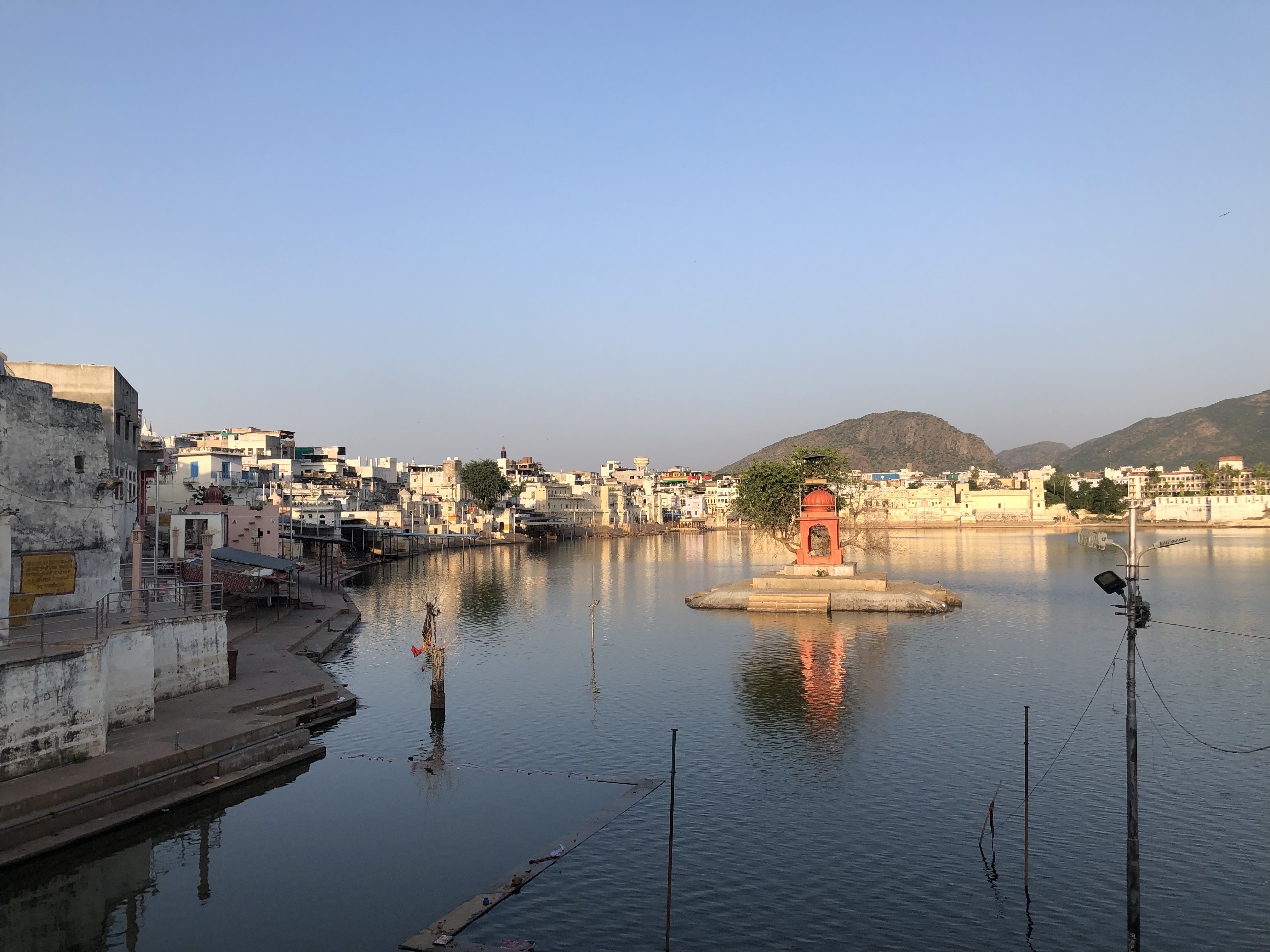 where there is an important sanctuary dedicated to Khwaja Muinuddin Chishti,
the founder of the first Sufi order in India. The place was super overcrowded, and the atmosphere is
totally
different compared to any other Islamic place I have ever visited. Even Islam is lived in a
different, Indian,
way: chaotic, noisy, and colorful. After that, we drove to Pushkar, a famous city for the
yearly
camels’ fair. I don’t have a good memory of that place. Along the sacred lake, there are various
Ghats, also
the one where Gandhi’s ashes were tossed. Among the people, there are so-called brahmins that make
you sit and
say a prayer asking for money. At this point, you cannot really refuse, and all the experience seems
more like
a scam. It is a pity because in Pushkar there is also one of the very few temples dedicated to
Brahma, a place
where a Hindu devoted should go at least once in his life.
where there is an important sanctuary dedicated to Khwaja Muinuddin Chishti,
the founder of the first Sufi order in India. The place was super overcrowded, and the atmosphere is
totally
different compared to any other Islamic place I have ever visited. Even Islam is lived in a
different, Indian,
way: chaotic, noisy, and colorful. After that, we drove to Pushkar, a famous city for the
yearly
camels’ fair. I don’t have a good memory of that place. Along the sacred lake, there are various
Ghats, also
the one where Gandhi’s ashes were tossed. Among the people, there are so-called brahmins that make
you sit and
say a prayer asking for money. At this point, you cannot really refuse, and all the experience seems
more like
a scam. It is a pity because in Pushkar there is also one of the very few temples dedicated to
Brahma, a place
where a Hindu devoted should go at least once in his life.
Finally, we left Pushkar and we arrived in Jaipur, where we had the best hotel so far.
The room we
had was huge. We had a sort of living room with sofa and armchairs, then a huge bed and a bathroom
that is
bigger than my room at home. It had a bathtub in the middle surrounded by marble columns! Outside,
there was
also a very nice swimming pool. We were lucky we stayed there two nights. And, did I already mention
it? It
was a haveli.
Day 8
In Jaipur, we had another “relax” day with no long transfers. Jaipur is the Rajasthan capital city
and one of
the few cities in India (maybe the only one?) with urban planning.
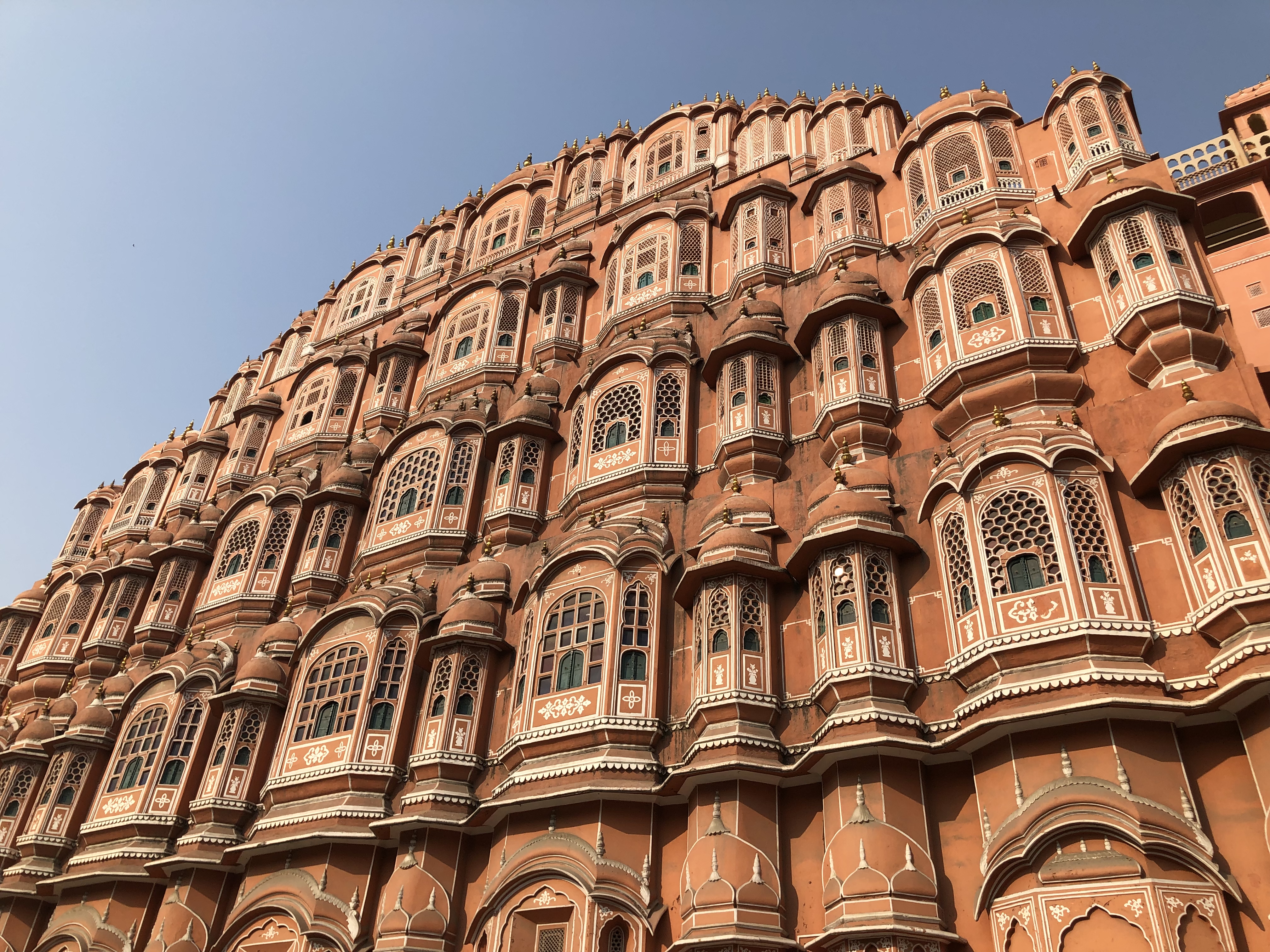 We met our guide in the morning and we headed first to the Hawa Mahal that we saw only from
the
outside. It is an incredible palace built in 1799 with red stone to allow the women of the court to
see the
life outside. After that, we drove to the Amber Fort, one of the most impressive in
Rajasthan. This was
built in 1592 as Amber was the capital of the Jaipur state. It is still now well preserved, and you
can get an
idea of how life was at the time.
On the way back to the city, we had a quick look at the water palace, another royal family’s palace
in the
middle of the lake. To complete the historical tour, we stopped at the Jantar Mantar that,
among all,
was the most interesting place in the city. Jai Singh II was a maharaja with a strong interest in
astronomy
and made this complex been built to have the most accurate calculations of time and stars movement.
You could
stay there for hours to see how all this stuff works!
We then spent the rest of the day wandering around until dinner, where we went to our guide’s home.
After
that, more wandering for some of us and some shopping. It was indeed the right day for shopping as
in two days
(the 27th of October) it would have been the culminating day of Diwali and it is tradition to
buy
something new to wear two days in advance.
We met our guide in the morning and we headed first to the Hawa Mahal that we saw only from
the
outside. It is an incredible palace built in 1799 with red stone to allow the women of the court to
see the
life outside. After that, we drove to the Amber Fort, one of the most impressive in
Rajasthan. This was
built in 1592 as Amber was the capital of the Jaipur state. It is still now well preserved, and you
can get an
idea of how life was at the time.
On the way back to the city, we had a quick look at the water palace, another royal family’s palace
in the
middle of the lake. To complete the historical tour, we stopped at the Jantar Mantar that,
among all,
was the most interesting place in the city. Jai Singh II was a maharaja with a strong interest in
astronomy
and made this complex been built to have the most accurate calculations of time and stars movement.
You could
stay there for hours to see how all this stuff works!
We then spent the rest of the day wandering around until dinner, where we went to our guide’s home.
After
that, more wandering for some of us and some shopping. It was indeed the right day for shopping as
in two days
(the 27th of October) it would have been the culminating day of Diwali and it is tradition to
buy
something new to wear two days in advance.
Now, you may wonder what Diwali is. Diwali, also known as the Festival of Lights, is the
celebration in Hinduism of the victory of light over darkness, good over evil, and knowledge over
ignorance.
In the previous days, celebrants prepare by cleaning, renovating, and decorating their homes and
workplaces.
During the climax, revelers adorn themselves in their finest clothes, illuminate the interior and
exterior of
their homes with diyas (oil lamps or candles), offer puja (worship) to Lakshmi, the goddess of
prosperity and
wealth, light fireworks, and partake in family feasts, where mithai (sweets) and gifts are shared.
Diwali is
also a major cultural event for the Hindu and Jain diaspora from the Indian subcontinent. So,
something quite
big in India that we were preparing to experience!
Day 9
Unfortunately, the day we had to leave our beautiful hotel and the beautiful Jaipur has come and we
left with
Agra as our destination. Along the way, however, we also had two other interesting stops. The
first
was in Abhaneri, where there is an impressive well. I mean, not a well as we imagine it but
with stairs
designed with a unique geometry.
After that, we went to Fatehpur Sikri. This archaeological site is a fortified city built in
the XVI
century and capital for a very short time of the Moghul Empire. Due to the lack of water, the city
was then
abandoned and forgotten. Nowadays, we can admire the perfect Indo-Islamic architecture and just
imagine how it
must have been in the past. Next to it, there is a mosque still in use and where many devotes go to
pray at
the tomb of the Sufi saint Shaikh Salim Chishti.
We were in a bit of a rush for this visit as the drive to Agra was still a bit long and we wanted to
make it
before the sunset to have at least a brief view of the Taj Mahal. And so it was, we arrived
just in
time to catch a glimpse of it.
Day 10
The morning was tough as we woke up at 4.30 to be inside the Taj Mahal complex before sunrise. It
was totally
worth it. In the beginning, when you enter, you only see all the people. Then, you see the mausoleum
and it is
a big emotion. It is nothing different from what we
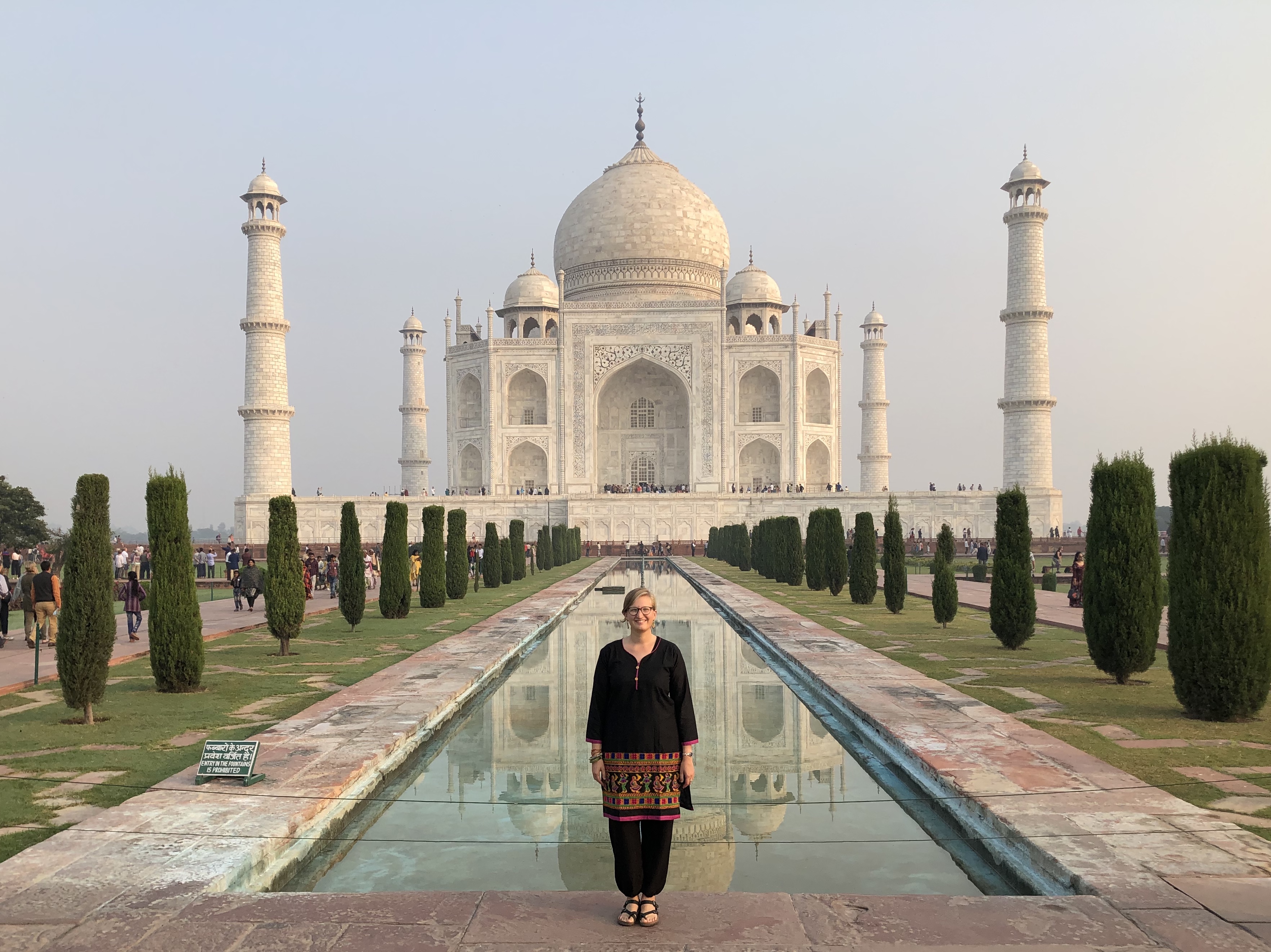 saw already in pictures, advertising, movies, and books but it is still one of the most beautiful
things I
have ever seen. It is not a case that the poet Tagore described it as a marble tear still on the
cheek of
time.
Now, you may know the story, but I will tell you just in case. The mausoleum was built by Shah
Jahan in
memory of his third wife, Mumtaz Mahal, who died in 1631 giving birth to their 14th child.
According to
the legend, Shah’s hair became white for the desperation. The building of the entire complex took
more than 20
years. In the meantime, Shah’s son overthrew him and put him in the Agra Fort from which he
could see
the Taj Mahal from afar and where he spent the rest of his life. At his death, he was put next to
his beloved
wife.
After the visit, we went back to the hotel, had breakfast, and went to visit the Agra Fort. Even
though we
were growing a bit tired of forts, this was indeed worth it. It was also very different from the
ones we saw
before (well, we were not in Rajasthan anymore either). Its architecture is Moghul and the building
is
immense. The materials used are marble and red sandstone. It would have been also nice if there was
a bit less
smog and we could appreciate the view but what I learned in India is that air pollution is, sadly,
common.
saw already in pictures, advertising, movies, and books but it is still one of the most beautiful
things I
have ever seen. It is not a case that the poet Tagore described it as a marble tear still on the
cheek of
time.
Now, you may know the story, but I will tell you just in case. The mausoleum was built by Shah
Jahan in
memory of his third wife, Mumtaz Mahal, who died in 1631 giving birth to their 14th child.
According to
the legend, Shah’s hair became white for the desperation. The building of the entire complex took
more than 20
years. In the meantime, Shah’s son overthrew him and put him in the Agra Fort from which he
could see
the Taj Mahal from afar and where he spent the rest of his life. At his death, he was put next to
his beloved
wife.
After the visit, we went back to the hotel, had breakfast, and went to visit the Agra Fort. Even
though we
were growing a bit tired of forts, this was indeed worth it. It was also very different from the
ones we saw
before (well, we were not in Rajasthan anymore either). Its architecture is Moghul and the building
is
immense. The materials used are marble and red sandstone. It would have been also nice if there was
a bit less
smog and we could appreciate the view but what I learned in India is that air pollution is, sadly,
common.
After the visit, we took the bus and left for Orchha, a city I didn’t know existed until
this
travel but that was a beautiful and unexpected surprise. The hotel we were in was super nice and, as
I
mentioned, it was the culminating day of Diwali. We arrived and they put us on flower necklaces, and
they had
decorations everywhere. They also fired some crackers and put music on. It was just beautiful.
Day 11
Today was pretty intense. We went to the city center of Orchha. As I said, this city was an
unexpected
surprise. Its history is connected to the Bundela rajput clan, who elected it as their
capital in 1531
until 1783.
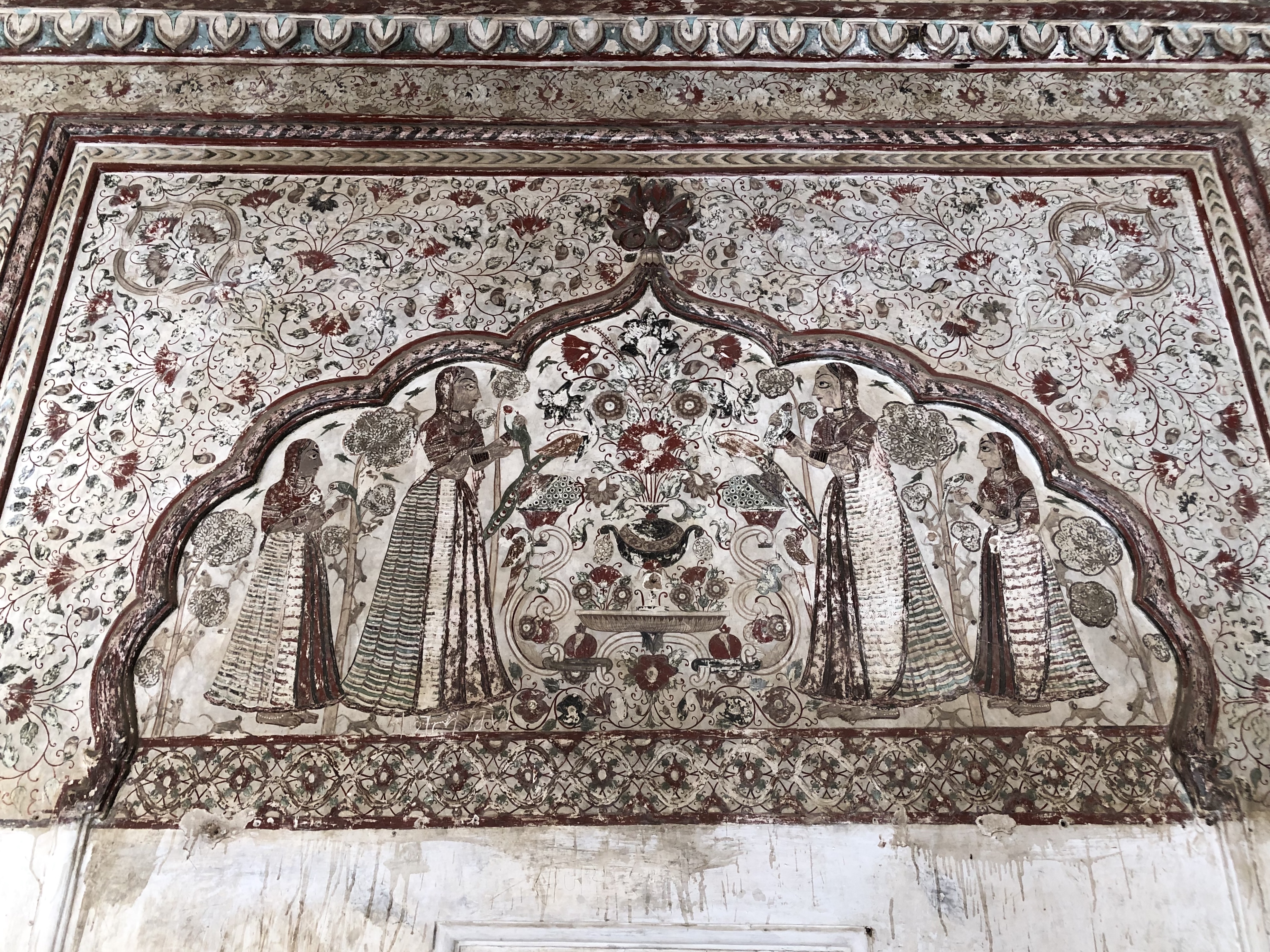 Because of this, there are many royal palaces and cenotaphs that is possible to visit.
What surprised me the most was that inside these palaces there are still very well preserved and
beautiful
frescoes. Just imagine immense palaces decorated in every corner! Unfortunately, as often in India,
there is
no care for this heritage and everything is more or less abandoned. It is also true that this is my
European
point of view talking and in Asia there is not the same concept of conservation they have there. And
in some
regards, the abandonment gives to this place an additional charm.
We found a guide that walked us around talking in a terrible English. The result is that we learned
almost
nothing and we had to work on imagination. After three hours, the visit was done and we wandered for
a bit in
the city. It was full of people and street vendors as everyone was still celebrating Diwali and
going in
pilgrimage to the Ram Raja Temple. As the name says, this temple is dedicated to god Rama
and,
especially in Diwali, the pilgrims are many. We then sat in a bar to relax a bit and just enjoy the
celebrations. It was anyhow not bad when we drove back to the hotel in the afternoon and stayed a
bit at the
pool. Later we went to another hotel for dinner and then had a final walk in the city and saw all
the pilgrims
still celebrating and chanting around the temple.
Because of this, there are many royal palaces and cenotaphs that is possible to visit.
What surprised me the most was that inside these palaces there are still very well preserved and
beautiful
frescoes. Just imagine immense palaces decorated in every corner! Unfortunately, as often in India,
there is
no care for this heritage and everything is more or less abandoned. It is also true that this is my
European
point of view talking and in Asia there is not the same concept of conservation they have there. And
in some
regards, the abandonment gives to this place an additional charm.
We found a guide that walked us around talking in a terrible English. The result is that we learned
almost
nothing and we had to work on imagination. After three hours, the visit was done and we wandered for
a bit in
the city. It was full of people and street vendors as everyone was still celebrating Diwali and
going in
pilgrimage to the Ram Raja Temple. As the name says, this temple is dedicated to god Rama
and,
especially in Diwali, the pilgrims are many. We then sat in a bar to relax a bit and just enjoy the
celebrations. It was anyhow not bad when we drove back to the hotel in the afternoon and stayed a
bit at the
pool. Later we went to another hotel for dinner and then had a final walk in the city and saw all
the pilgrims
still celebrating and chanting around the temple.
Day 12
Another day, another early alarm. We drove to Khajuraho and the road was one of the worst we
saw so
far. We basically jumped every minute, especially me, seating in the back.
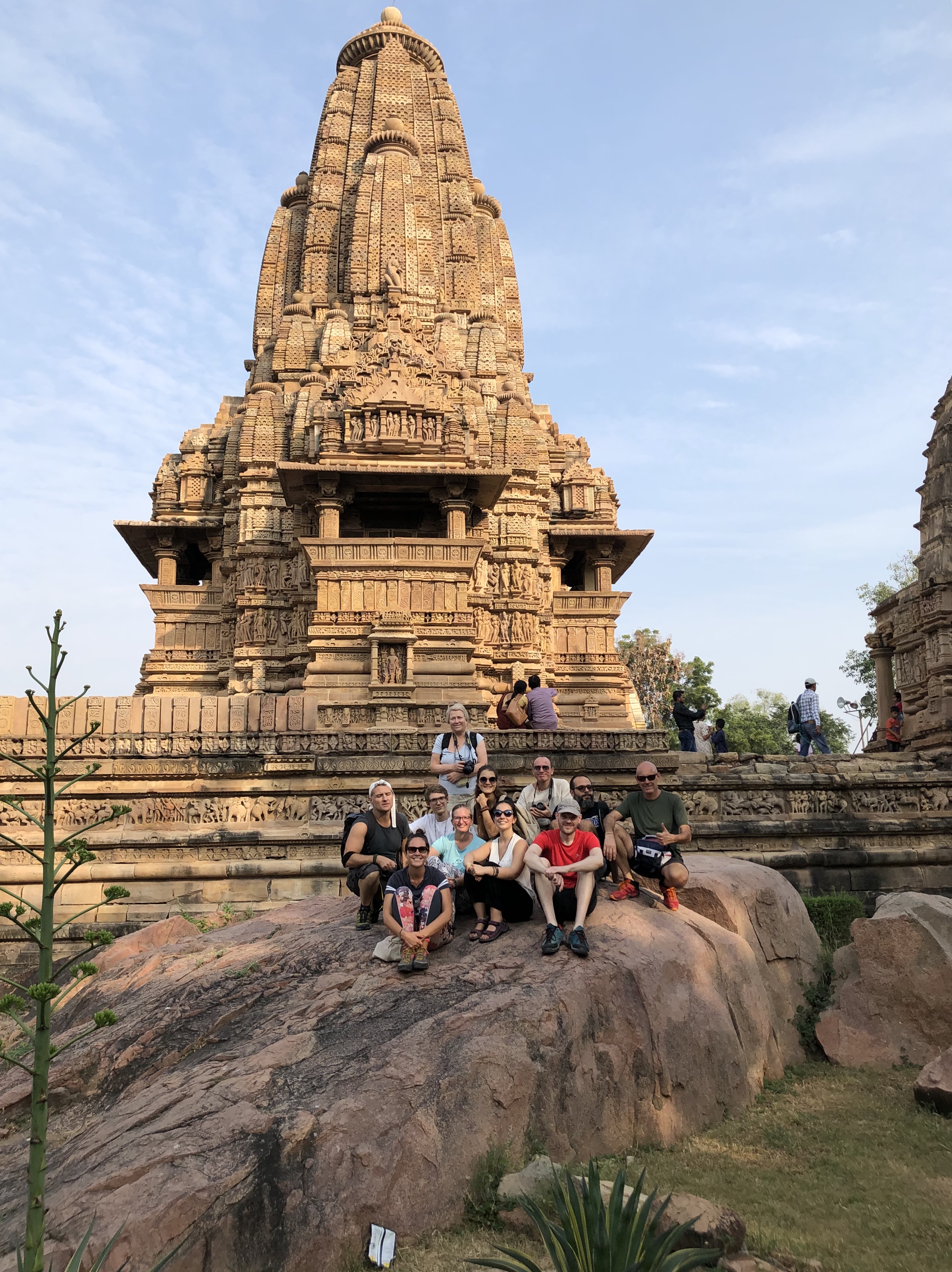 Arrived in Kajuraho, we left our stuff in the hotel and went to the city with our guide. This city
is mostly
famous for its temples with erotic sculptures and indeed they were interesting. However, they
are not
the only representations you see as all the temples are a sort of comic of the time (time being the
X and XI
centuries). 85 were the temples erected in the area but only 25 survive now and only one is still
used as a
temple for ceremonies.
We first went to visit the occidental group, where the best preserved and beautiful are enclosed in
order to
take care of them. In truth, they are all very similar to each other, having even the same scenes
depicted all
around, but seeing all of them at glance is incredible. Some of the erotic scenes are really absurd
and the
guide even warned us not to try them unless we were yoga pro!
Arrived in Kajuraho, we left our stuff in the hotel and went to the city with our guide. This city
is mostly
famous for its temples with erotic sculptures and indeed they were interesting. However, they
are not
the only representations you see as all the temples are a sort of comic of the time (time being the
X and XI
centuries). 85 were the temples erected in the area but only 25 survive now and only one is still
used as a
temple for ceremonies.
We first went to visit the occidental group, where the best preserved and beautiful are enclosed in
order to
take care of them. In truth, they are all very similar to each other, having even the same scenes
depicted all
around, but seeing all of them at glance is incredible. Some of the erotic scenes are really absurd
and the
guide even warned us not to try them unless we were yoga pro!
After the temples, we went to see the old part of the town as we were waiting for the sunset to
attend a
puja (prayer). The town was nothing exceptional but I discovered that there is a celebration even
for cows
poo during Diwali. Poo is burned in front of every house for luck. Maybe we should try, in
Switzerland
it should not be hard to find some!
The puja we attended at sunset was perhaps the most authentic one. It was in the only ancient temple
in
Khajuraho still active as temple. It is dedicated to Shiva and inside there is a huge lingam (a
fallic symbol
of Shiva) and the prayer consisted in a long, deafening bell ringing. At the beginning was
fastidious but
after a while you could feel you were almost going into a trance.
Day 13
The night was short as we all, except for the coordinator, signed up to go to the Panna Tiger
Reserve
to see… the leopard! No, kidding, to see the tiger! We were on three different jeeps and mine was
super lucky
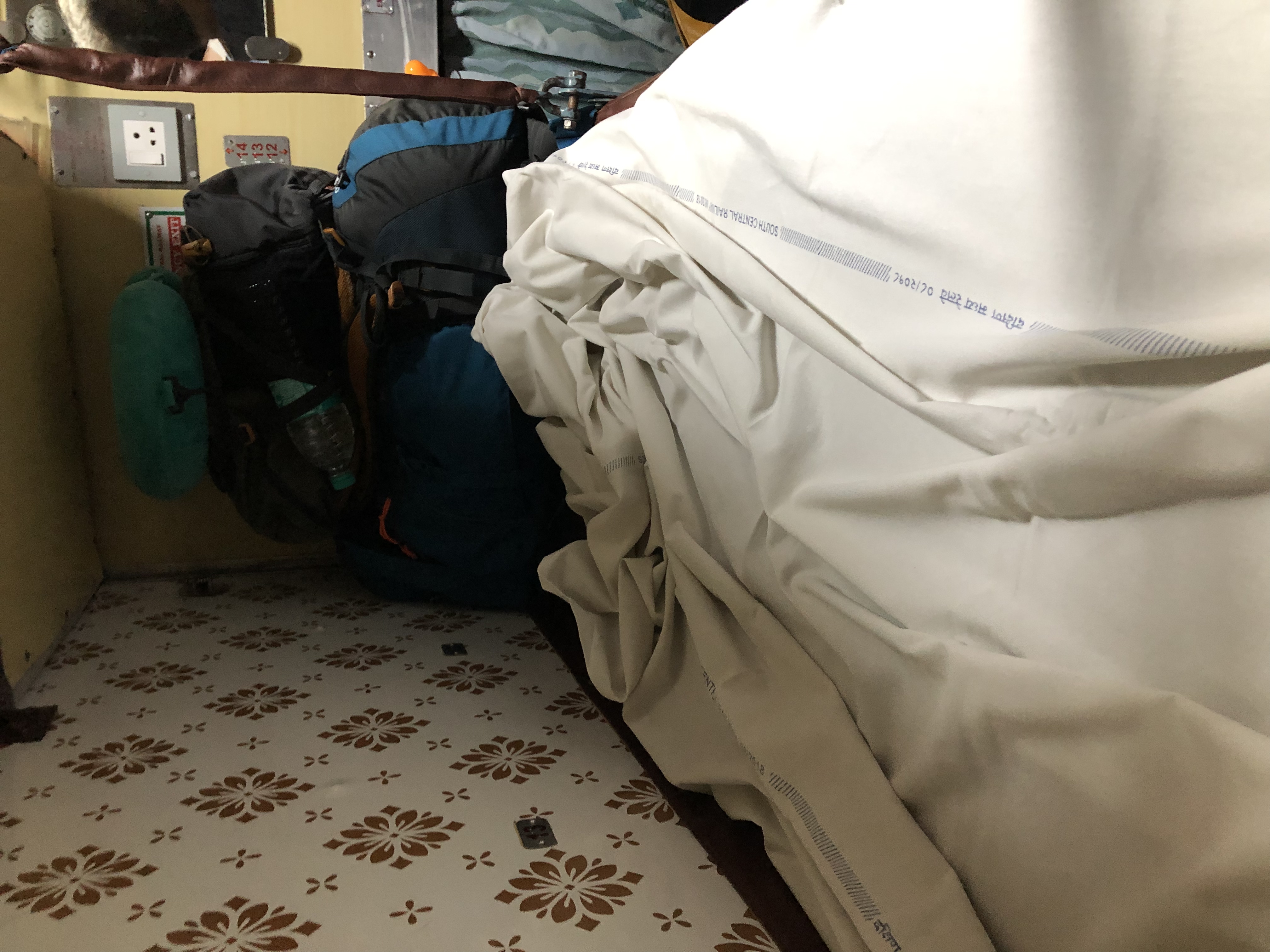 as we saw a tiger soon. She crossed the street and did not even pay attention to us. Moreover, we
were the
only car there, so we really enjoyed that moment. The safari itself was ok, it is basically designed
to see
the tiger. However, given the fact that we saw her at the beginning, we then drove to some other
areas and saw
other animals (lots of spiders!) and panoramas. Once back, we had breakfast and then we went to see
other
temples in Khajuraho. Early in the afternoon we left with the bus to go to Satna where we
said goodbye
to our driver and started a new adventure: taking a (night) train in India (to Varanasi).
as we saw a tiger soon. She crossed the street and did not even pay attention to us. Moreover, we
were the
only car there, so we really enjoyed that moment. The safari itself was ok, it is basically designed
to see
the tiger. However, given the fact that we saw her at the beginning, we then drove to some other
areas and saw
other animals (lots of spiders!) and panoramas. Once back, we had breakfast and then we went to see
other
temples in Khajuraho. Early in the afternoon we left with the bus to go to Satna where we
said goodbye
to our driver and started a new adventure: taking a (night) train in India (to Varanasi).
The station in Satna is not super big but it was still quite hard to find our train. First, all
the signs
were in Hindi. I did not mention it before, but Indians are not very good at speaking English so
even asking
information was sometimes hard. As the coordinator was not keen in giving us the booking references
and our
train seemed to have disappeared from every screen, we had to start asking people. Apparently, there
is an app
they use which is very accurate but not on my phone (probably you need to be Indian to be able to
use it).
After some, expected, hours of waiting, our train finally arrived. We then had to find our seats
(not easy as
we did not have the references…) and prepare our comfortable beds. It was not so bad, only the super
tall
people struggled a bit especially because we kept our baggage on the beds with us, so we had less
space left.
The beds were ok, and we even had sheets. Also the toilets were ok. We set our alarms and tried to
sleep a
bit.
Day 14
The night was ok, we had a bit of sleep but not too much as we were also worried to get down at the
right
station. The train would continue for another entire day to go who knows where. Some people helped
us and some
of them were curious about us. I bet it is not very common to see a bunch of western people on a
night train
as we were, especially on a less used line (the train from Khajuraho was fully booked).
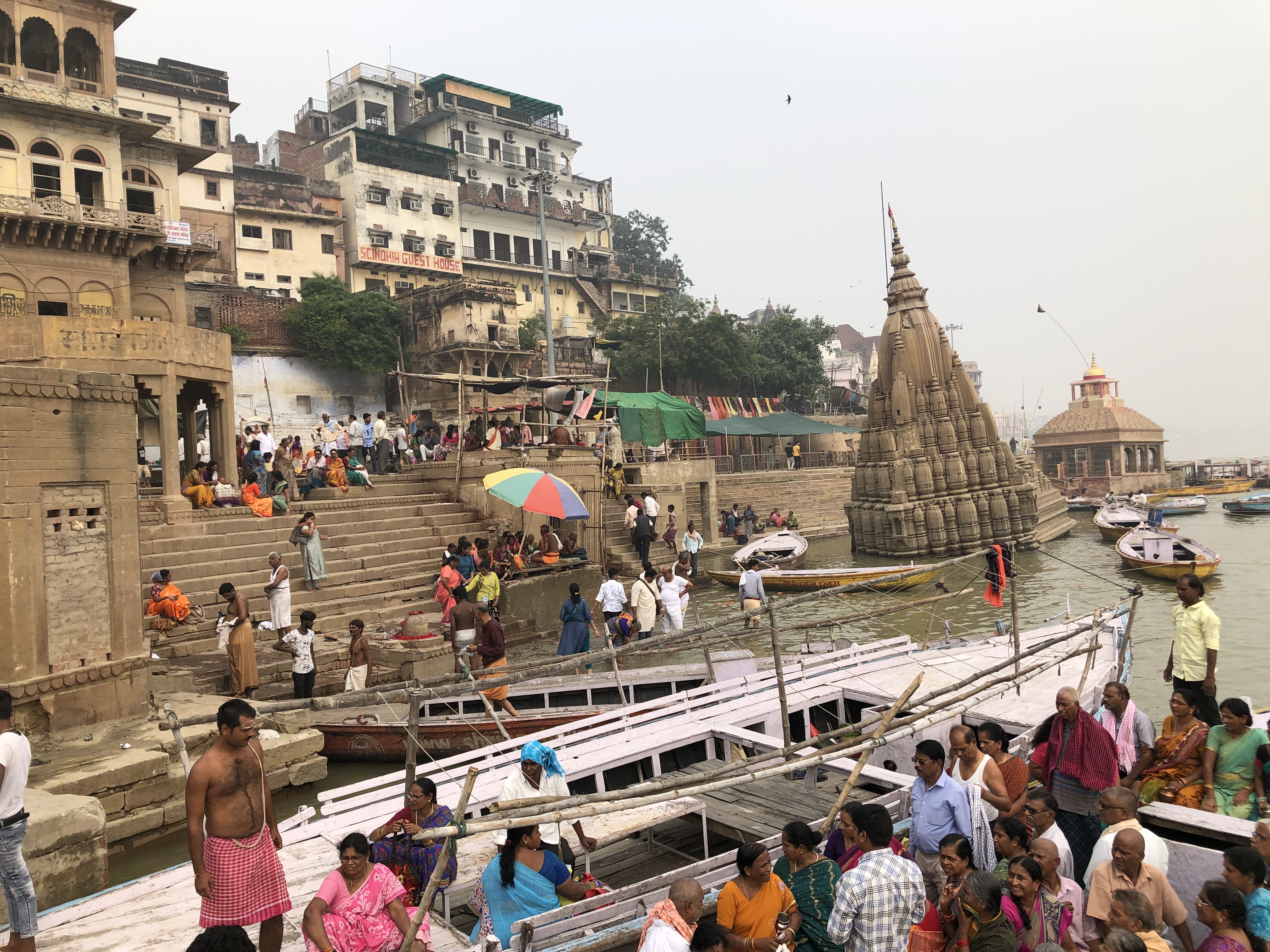 In Varanasi we were picked up by a guide that drove us to our hotel. We would have never
found it if it
was not for him but at least the hotel was in a strategic position just in front of the Gange river.
In Varanasi we were picked up by a guide that drove us to our hotel. We would have never
found it if it
was not for him but at least the hotel was in a strategic position just in front of the Gange river.
Varanasi is another world. Even after two weeks in India, you are not completely prepared for
it. It is
humid, it is dirty, it is rotting, it is dead and alive, it is smelly. I thought people were
exaggerating in
saying not everyone can stand it but now I can say I agree. For me it was a bit shocky at the
beginning but
then I did not care too much. I just followed the stream, literally. We again left our stuff in the
rooms and
went out to explore. We walked along the river for a while seeing all the ghats (stairs)
where people
go to bath, to wash their clothes, to pray and to do all possible daily activities. Of course, we
also went to
see the burning sites. Varanasi is considered, in fact, the best place where to die and all the
Hindus want to
have their ashes spread in the sacred river. Who dies here will never reincarnate again and his soul
will be
free. We saw some temples even if many are inside the houses walls and therefore private. Early in
the
afternoon we went back to the hotel to rest a bit. Soon, anyway, we had to move to meet our guide to
go on the
Gange with a boat at sunset. It was nice seeing the city from a little afar. In a way it was
refreshing not to
be immersed in the crowd and its smell but it was short as we then went to the puja. This time, I
did not like
it that much as it seemed fake. But maybe the show off and the kitsch is part of the Hinduism
rituals and it
was more authentic than I thought.
Day 15
In the morning, we took the boat again and saw the sunrise from there. The shore was already full of
people
bathing and praying before starting the morning and the pyres were burning as they do at every hour.
5 of us
decided then to have a yoga lesson so we went to our guide’s home rooftop where a young Russian now
living in
India girl taught us for almost two hours. My back after that was hurting so much! But the
experience was
nice. I mean, when will I experience again yoga in Varanasi?
The rest of the day was quiet, I stayed in the hotel while the rest was shopping around a bit and in
the
afternoon we all went to the airport to fly to New Delhi. The flight was ok but once in Delhi, the
pick up bus
was not there. After some calls, we found out the guide with the bus was waiting in the wrong place
so it was
not a major issue and we soon arrived at the hotel.
Day 16
As our last day in India, this was not a great day. Delhi is ugly, not because there are ugly
things
but because it is a chaotic metropolis immerse in the smog.
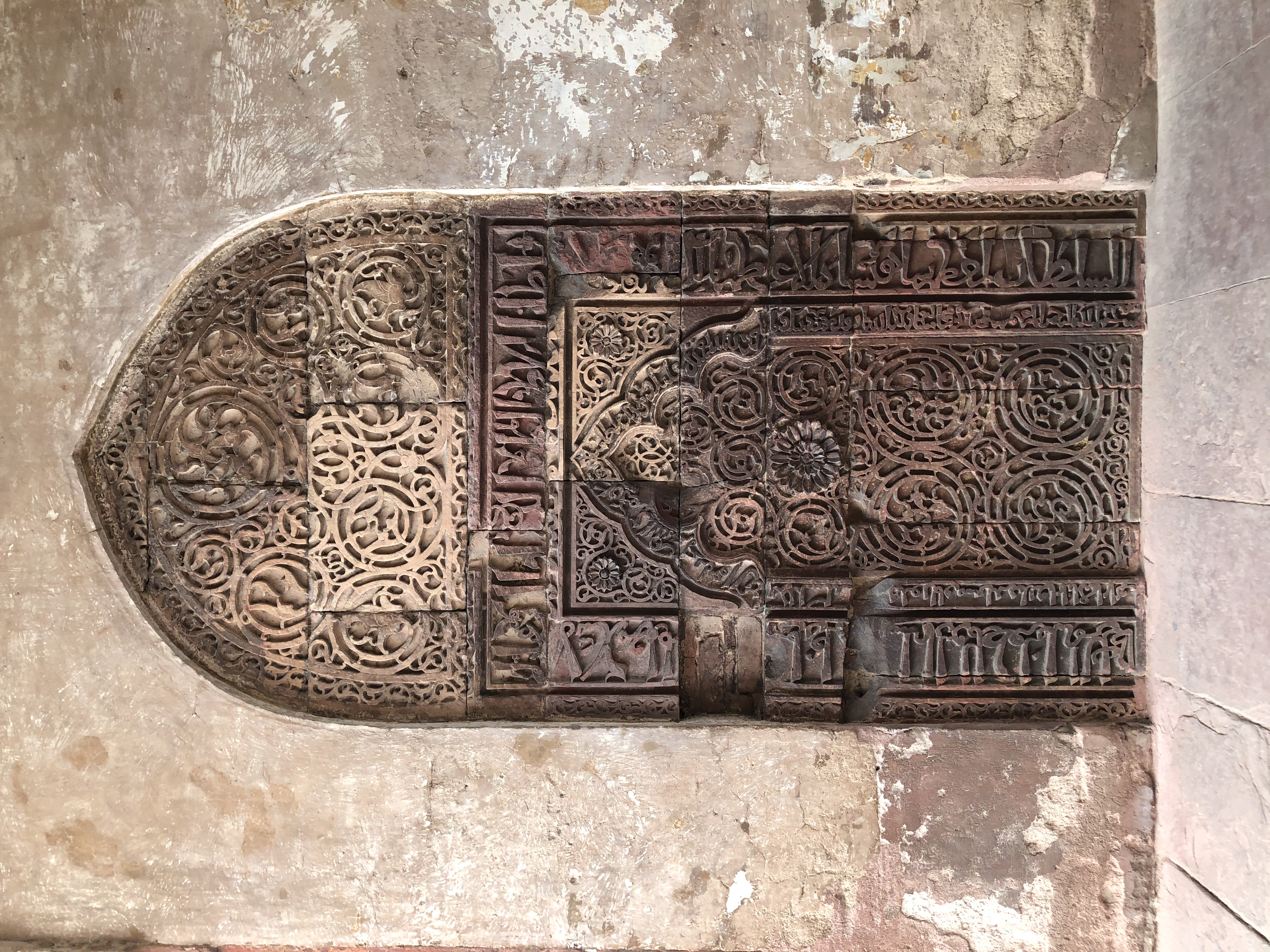 It was hard even breathing. In addition to that,
the group kind of broke up: the young couple left and went to explore alone and the others were all
nervous
and tired. I was actually quite interested in seeing something of the city and we also had a bus
booked for us
all day. In the end, we managed to see just a couple of things.
We went to see the Red Fort (what if not a fort to conclude our trip?) but it was hard to
enjoy it: the
smog was covering it all.
Later we went to the Lotus Temple that was the most surprising thing. It is a temple with a
lotus
flower shape in which all the religions are welcomed and you can pray or meditate. Only five of us
went but it
was really worthy! It is a pity we did not get to see all the others sights but we were not even in
the spirit
of enjoying them. We had our last supper next to our hotel. It was good but my stomachache (it
started few
days before, most probably due to tiredness) did not allow me to enjoy it that much.
It was hard even breathing. In addition to that,
the group kind of broke up: the young couple left and went to explore alone and the others were all
nervous
and tired. I was actually quite interested in seeing something of the city and we also had a bus
booked for us
all day. In the end, we managed to see just a couple of things.
We went to see the Red Fort (what if not a fort to conclude our trip?) but it was hard to
enjoy it: the
smog was covering it all.
Later we went to the Lotus Temple that was the most surprising thing. It is a temple with a
lotus
flower shape in which all the religions are welcomed and you can pray or meditate. Only five of us
went but it
was really worthy! It is a pity we did not get to see all the others sights but we were not even in
the spirit
of enjoying them. We had our last supper next to our hotel. It was good but my stomachache (it
started few
days before, most probably due to tiredness) did not allow me to enjoy it that much.
Day 17
This was the day we were leaving and the day we had a real adventure in the airports. We left early
but then our
flight was delayed of several hours because of the smog. Our reservation was under Turkish Airlines
but the
flight from Delhi to Istanbul was operated by Indigo, a low cost company. We arrived super late in
Istanbul and,
even if the gate was still open, the hostesses refused us to get on the plane.
At that point some in the groups got super upset. We went to the transfer desk to get new boarding
passes and,
after 5 hours (!), we got them. We had to speak with several people as Indigo was blaming Turkish
and viceversa.
In the beginning, they only gave us new tickets that were for flights in 48 hours! The final ones we
got were
for the next afternoon so we also had to find a place to sleep. Of course no company paid for that.
In the desperation of the moment, we were lucky Istanbul airport has a hotel just inside so we did
not have to
find other, far, places where to go. The hotel was actually very nice and the beds amazing and
thankfully they
had space for all of us.
The day after we were all in a better mood and had breakfast to start the day. We had to fight again
with
Turkish to get the lunch vouchers but managed to get those, too.
Finally, at 4, we left Istanbul to Milan. It may seem it is over if it was not for the six missing
suitcases
(not mine, thanks Ganesh!) that apparently decided to stay behind.
For many reasons, this is a travel I will remember dearly. India is a fascinating place full of contradictions and too easily portrayed. In some moments, I felt like it was enough but now I wish to go back to India and explore it a little more. Hopefully it will happen soon!